Different Experiences, Different Perspectives
Developed by Andrew Leveillee, PCM Playful Practicum 2022
(FOCUS: K-2, 3-5, Visual Arts, Civics & Culture, History & Humanities, Language & Literacy, SEL)
Different Experiences Different Perspectives Printable
This lesson/activity explores what shapes a child’s identity. It provides children a vehicle to examine how they see themselves, how they see others, and how others may see them. It touches upon the themes of awareness, perspective, equality, empathy, the shared experiences that can help build a community, and the individual experiences that make us unique.
Students will create tokens of themselves and the experiences that have shaped them. They will use various materials to identify how their experiences have shaped their identities and how that informs how they see others/how others may see them.
Materials
- Four or more bins/wide shallow contains that allow for students to place their hands/objects into.
- Duct tape, clay, or play dough
- Recycled Materials – cut up pieces of string, pipe cleaners, shredded wrapping paper, sand, pencil shavings, confetti, beads, etc. Enough needed to fill each bin with one type of material.
Set Up
The space can be arranged in centers with various stations featuring one bin filled with materials. This allows for greater reflection as students move along the process at their own speed and order. However, a second option is to arrange bins in a line as more of a factory assembly line. This may help if greater facilitation and support is necessary. Students can then work in small groups or as individuals.
Do materials need to be prepped in advance?
Bins should be filled with the assorted materials. If clay or play dough is being used it should be sectioned out in equal quantities for each student. It would be helpful to section out the duct tape if that is being used. Some form of graphic organizer to capture student reflections is ideal.
Student’s Job
Identify how their experiences have shaped their identities and how that informs how they see others/how others may see them.
- Brainstorm: WHO ARE YOU?! Students should consider (via group discussion, think/pair/share, or on a graphic organizer) what experiences helped shape how they identify who they are. The guiding question as they prepare to build: What is your identity and what experiences (good and bad) in your life have helped shape that identity (make you who you are)?
- Build: Students create a representation of themselves by showing how experiences helped shape who they are.
- Create a duct tape cylinder (or any shape the student would like) sticky side out.
- This can also be a clay or playdough molded into any shape including a figure.
- Students place their token (duct tape cylinder/playdough/clay figure representing themselves) into any number of the mix material bins. These bins can be filled with any manner of materials that will adhere to the token. This can include cut up pieces of string, pipe cleaners, shredded wrapping paper (various designs can represent different things to each student), sand, pencil shavings, confetti, beads, etc.
- As they place their tokens in the bins (or drag them, or dip them, however they want to interact with the material) pieces of the material should adhere to their token creating a lasting effect.
- After each interaction with their token and a mix material box they should complete a section on a graphic organizer describing what experience that material represents and how it has shaped them. Depending on levels this could be written or drawn. See “Effective Facilitation” for sample organizer
- After multiple bins, their token should be covered with all sorts of materials representing varied experiences. Their organizers should describe their interpretations of each one. It can be reinforced to students that this represents “experiences leaving their marks.
- Reflection: Once students complete their token and corresponding organizers a community can be created with all the separate individuals. Students can share out their tokens or they can be displayed along with the graphic organizers. Students can view each others’ representations and note the complexity of experiences. Additionally they can note how materials that may have been a positive experience or meant one thing to them, could represent a totally different experience for someone else.
Further Challenges:
Identify common experiences that we share and practice empathy through relating to other’s experiences.
Create a token for a historical figure or family member.
Discuss quotes around identity, awareness, perspective, and how they relate to student experiences following the activity. See “Effective Facilitation” for sample quotes.
Teacher’s Job
Standards Alignment
RI EARLY LEARNING AND DEVELOPMENT STANDARDS: SOCIAL EMOTIONAL DEVELOPMENT
Social and Emotional Development (SE)
SE 2: Sense of Self SE 2.a: Children develop an awareness of themselves as an individual with unique thoughts, feelings, and perspectives.
RI EARLY LEARNING AND DEVELOPMENT STANDARDS: SOCIAL STUDIES
Social Studies (SS) SS 1: Self, Family, and Community SS 1.a: Children gain awareness of how they relate to their family and community, understand social roles and responsibilities, and recognize and respect similarities and differences in people.
SOCIAL STUDIES: HISTORICAL PERSPECTIVES 5 (K-2)-1
Students demonstrate an understanding that a variety of factors affect cultural diversity within a society by… recognizing cultural differences and similarities between individuals, groups, or communities (e.g., customs, beliefs, language, religious faiths).
SOCIAL STUDIES: GEOGRAPHY 2 (K-2)-3
Students understand different perspectives that individuals/groups have by… identifying and describing how people in different places view their environments (e.g., home, classroom, neighborhood, community).
Vocabulary Acquisition and Use:
CCSS.ELA-LITERACY.CCRA.L.4
Determine or clarify the meaning of unknown and multiple-meaning words and phrases by using context clues, analyzing meaningful word parts, and consulting general and specialized reference materials, as appropriate.
Vocabulary – identity, perspective, empathy, experience.
With an accompanied writing piece to describe their figure and their process:
CCSS.ELA-LITERACY.CCRA.W.2
Write informative/explanatory texts to examine and convey complex ideas and information clearly and accurately through the effective selection, organization, and analysis of content.
CCSS.ELA-LITERACY.CCRA.W.3
Write narratives to develop real or imagined experiences or events using effective technique, well-chosen details and well-structured event sequences.
Prepare/ Background Info
Depending on levels, it may be appropriate to scaffold “what is identity?”.
Activities to support this include:
One fact index card
Students will identify one aspect that makes up their identity. This can be modeled to support the idea. They will explore how others may see or share that aspect.
Students write or draw one fact about themselves that they would not mind sharing with the class. The cards are collected and either read (or placed around the room as a gallery walk). Students guess what fact could go with what student. Students may learn new facts about their classroom community members, as well as learn about possible aspects that they have in common.
Create a visual of your identity:
Use EdWordle to create an identity word map/cloud or use an identity chart . Compare different individuals’ word maps/clouds to highlight shared and varied identifiers along with how complicated identities can be.
Effective Facilitation
A: Complete the graphic organizer.
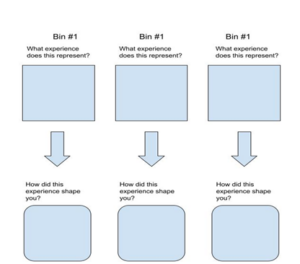
B:
Discuss the following MLK quotes using the necessary images and definitions to help support varied Lexile levels.
- “The ultimate measure of a man is not where he stands in moments of convenience and comfort, but where he stands at times of challenge and controversy.”
From his 1963 book, Strength to Love. - “Darkness cannot drive out darkness; only light can do that. Hate cannot drive out hate, only love can do that.
From Strength to Love. - “I have a dream that my four little children will one day live in a nation where they will not be judged by the color of their skin, but by the content of their character.”
From his famous August 1963 “I Have a Dream” speech. - “Whatever affects one directly, affects all indirectly.”
From his April 1963 “Letter from a Birmingham Jail.” - Our loyalties must transcend our race, our tribe, our class, and our nation; and this means we must develop a world perspective.”
From his 1967 Christmas sermon on peace.
Play to Notice
Ensure students design the figure (tape, clay, or playdough) in any way they would like. This is an additional way of representing themselves and the representation can be somewhat abstract. It involves some higher order thinking to connect the mixed materials (sand, beads, paper, etc.) and their transference to the token/figure as representing imparted effects of an experience. Modeling an example could be instrumental in understanding.
Content Matter to Notice
Use the graphic organizer to monitor students ability and understanding to connect experiences to their identity and perspectives.
During the share out (or community wall created by all the figures), note student ability to identify shared experiences, themes, and how different students may have approached the challenge differently.
SEL to Notice
Self-awareness – Are students able to understand who they are, their feelings and beliefs, how their past has helped shape them, and are they comfortable with that?
Self-management – Are students able to express potentially emotionally charged experiences, work with others as they do the same, and share resources while expressing themselves appropriately.
Social Awareness – Are students able to see other points of views and accept that they are formed by different experiences, can they empathize with others and accept differences?
Relationship skills – Are students able to continue to develop healthy and respectful relationships with their peers and adults and handle conflict appropriately.
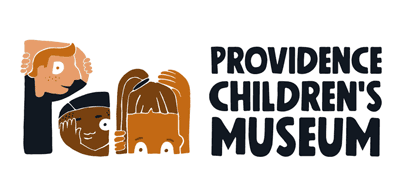
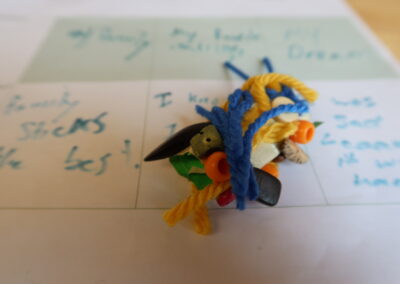
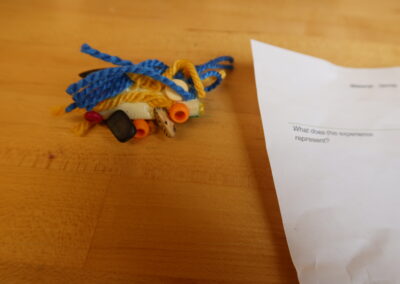
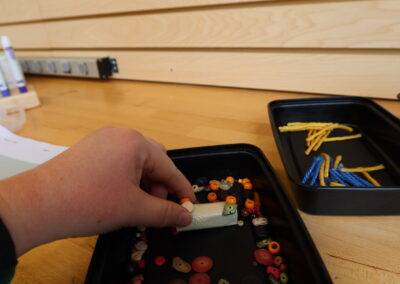
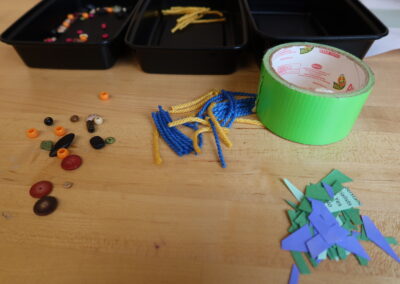
0 Comments